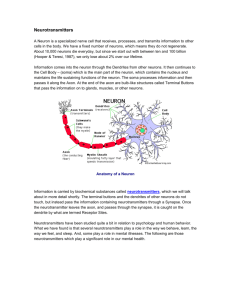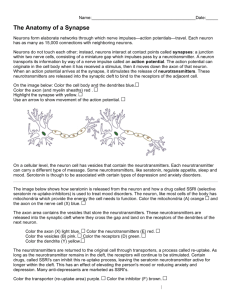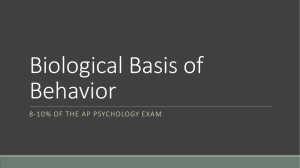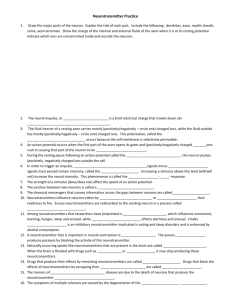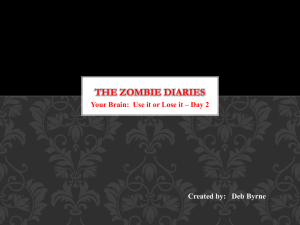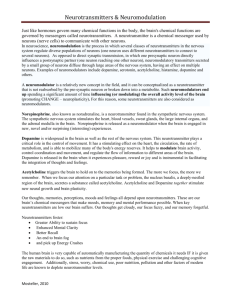Biological Basis of Behavior
advertisement
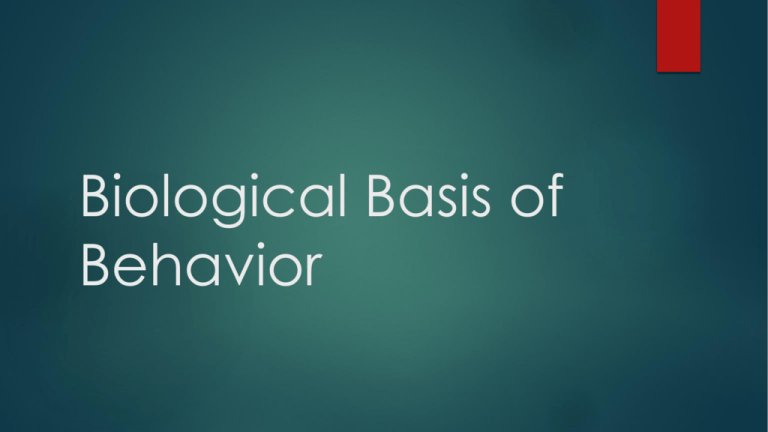
Biological Basis of Behavior The Neuron Dendrites Cell Body/Soma Axon (blue represents myelin sheathinsulation for electrical impulse) Axon Terminus/ Terminal Buttons Neuron Firing At rest, the neuron is in a state of resting potential Signal is received by receptors on the dendrite If the signal reaches the threshold an action potential is initiated Once an action potential is initiated there is an all-or-nothing response (it fires or it doesn’t) The action potential is an electrical impulse that travels down the axon When the electrical impulse reaches the terminal buttons, neurotransmitters or chemical messengers are released into the synapse the space between the sending neuron and the receiving neuron The neurotransmitters then bind with the receptors on the dendrite of the next neuron Excitatory neurotransmitters keep the signal going Inhibitory neurotransmitters stop the signal from continuing Once the action potential has been sent, the neuron must go through a refractory period a time of rest between impulses. During this time reuptake of neurotransmitters occurs when they are brought back into the original sending neuron in preparation to be used again. Neurotransmitters Chemical messengers that send a signal from one neuron to the next Remember! The signal through one neuron is due to electricity, signals between neurons is due to chemicals Neurotransmitters Function Too Much Too Little Acetylcholine (Ach) Enables muscle action, memory, and learning Seizures Alzheimer's Dopamine Learning, movement, attention, emotion Schizophrenia Parkinson’s disease, tremors, depression when paired with low serotonin Serotonin Mood, hunger, sleep, arousal Depression Norepinephrine Alertness and arousal Depression GABA Major inhibitory neurotransmitter Seizures, tremors, insomnia Glutamate Major excitatory neurotransmitter, involved in memory Endorphins Released in response to pain Oxytocin Enables feelings of love and bonding Migraines and seizures Maladaptive social interactions; aggression Drugs and Neurotransmitters Agonist drugs The place of and serve the same function as a neurotransmitter Used when there is too little of a neurotransmitter present Antagonist Take the place of a neurotransmitter but interrupt its function Used when there is too much of something Divisions of the Nervous System The Endocrine System Closely associated with the nervous system Contains glands that release hormones into the blood stream Together with the nervous system maintains homeostasis our body’s internal balance Pituitary Gland- located in the base of the brain, known as the master gland because it controls all the others Adrenal Glands- top of kidneys, release epinephrine and norepinephrine in response to stress to trigger the fight or flight response Neurotransmitters vs. Hormones Neurotransmitters Hormones Chemical messengers Chemical messengers Nervous system Endocrine system Released from terminal buttons on the neuron into the synapse Released from endocrine glands into the blood stream Work fast Work slowly Don’t stay around long Stay around for a while Studying the Brain Electroencephalogram EEG Records the brain’s electrical activity Electrodes Can detect brain-wave activity assess brain damage and epilepsy Computer Tomography (CT or CAT Scan) Examines the brain by taking x-ray photographs Uses radiation Can diagnose brain damage, bleeding, and stroke Magnetic Resonance Imaging (MRI) Uses a magnetic field that detects the movement of electrons Produces a detailed image of the soft tissue in the brain Can show unique features or abnormalities in brain tissue Functional MRI (fMRI) Taking images before and after being asked to do a task Can show where blood is flowing during specific tasks or when eliciting specific emotion Positron emission tomography (PET) Shows functional areas of the brain by observing the presence of radioactive glucose Similar to fMRI can show what area of the brain is functioning during a specific task or emotional response Organization of the Brain Older Brain Structures Brainstem Medulla- heartbeat and breathing Pons- coordinates movement Reticular formation- controls arousal Thalamus Sensory control center, receives information from senses and sends it to the higher brain regions for processing Receives higher brain’s relies and directs the medulla and cerebellum Cerebellum Nonverbal learning and memory Coordinates voluntary movement Limbic System Hippocampus Relay center for conscious memory processing; “save button” Amygdala Emotional memory processing Specifically linked to fear and aggression Hypothalamus Bodily maintenance Hunger, thirst, body temperature, sexual behavior Also linked to emotion and reward Cerebral Cortex External area of the brain Where advanced thinking and planning occurs Where memories are stored Occipital Lobes Responds to visual stimuli Interprets what is being “seen” Temporal Lobes Hearing Language processing Memory Frontal Lobes Personality Intelligence Voluntary movement (centered in the motor cortex) Parietal Lobes Spatial location Attention Processes information about body sensation (somatosensory cortex) Association Cortex Neurons that make up about 75% of the cortex Integrate sensory and motor information


